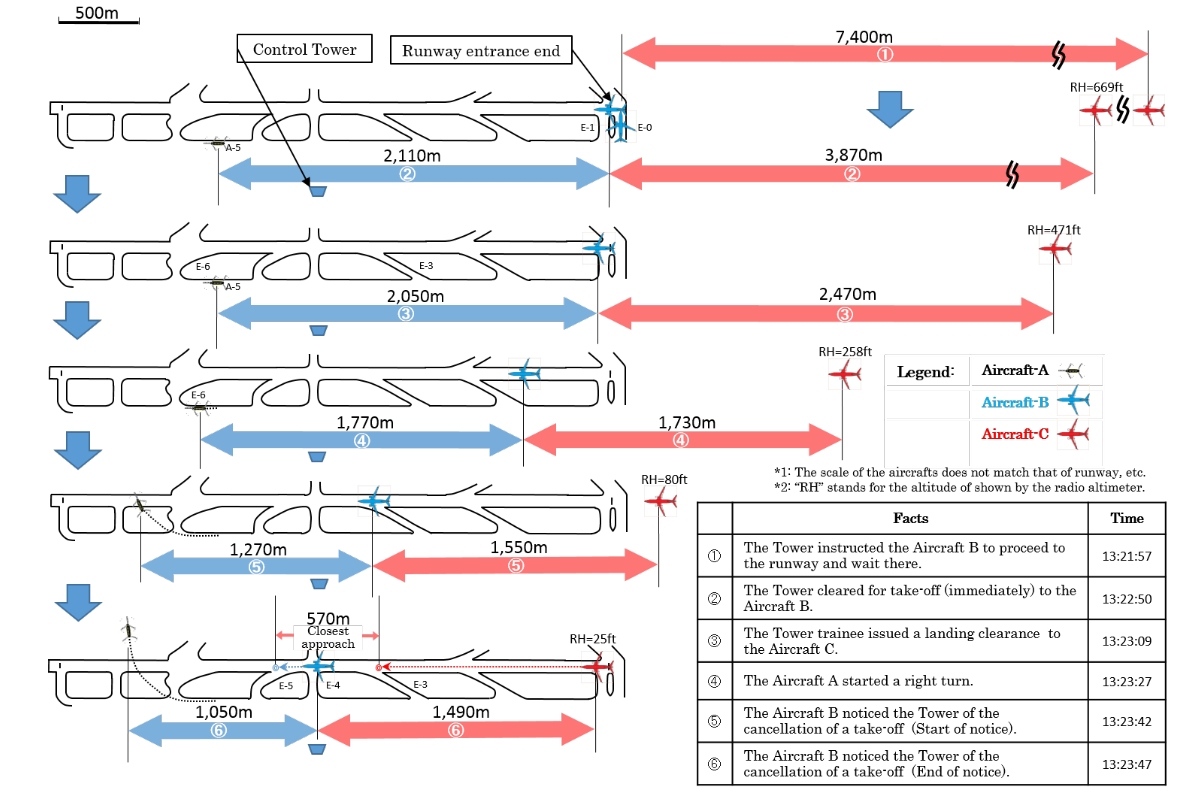
ASN Wikibase Occurrence # 176621
This information is added by users of ASN. Neither ASN nor the Flight Safety Foundation are responsible for the completeness or correctness of this information.
If you feel this information is incomplete or incorrect, you can submit corrected information.
| Date: | Wednesday 3 June 2015 |
| Time: | 13:23 |
| Type: |  Boeing 737-881 (WL) |
| Owner/operator: | All Nippon Airways - ANA |
| Registration: | JA80AN |
| MSN: | 44558/5216 |
| Year of manufacture: | 2014 |
| Fatalities: | Fatalities: 0 / Occupants: 83 |
| Aircraft damage: | None |
| Category: | Serious incident |
| Location: | Naha Airport (OKA/ROAH) -
 Japan Japan
|
| Phase: | Take off |
| Nature: | Passenger - Scheduled |
| Departure airport: | Naha Airport (OKA/ROAH) |
| New Chitose Airport (CTS/RJCC) | |
| Investigating agency: | JTSB |
| Confidence Rating: |
Two commercial aircraft and a military helicopter were involved in two successive serious runway incursion incidents at Naha Airport in Japan.
All Nippon flight ANA/NH1694, a Boeing 737-800 registered JA80AN, rejected take-off from runway 18 of Naha Airport, since Japan Air Self-Defence Force's CH-47J helicopter (registration 57-4493, 7 on board) took off toward Kumejima Airport (UEO/ROKJ) and flew across the runway from east to west without ATC take-off clearance during the take-off roll of the 737-800. The pilots of CH-47 mistook ANA's take-off clearance for its own. While JA80AN was on the runway after rejection of take-off, Japan Transocean Air flight JTA/NU610 from New Ishigaki Airport (ISG/ROIG), a Boeing 737-4Q3 (JA8938, C/N 29485/3085, 44 onboard), landed on the same runway, though the Naha tower ordered it to go-around.
There were no injuries. The flight ANA/NH1694 was cancelled after the incident, and JA80AN was out of service for maintenance.
Probable Causes:
It is certain that this serious incident occurred as follows: when the ANA Aircraft rejected a take-off on the runway 18 due to the SDF Aircraft crossed over in its front, and the JTA Aircraft landed on the runway 18 before its vacating.
It is probable that the JTA Aircraft landed on the runway was because the PIC, recognizing the existence of the ANA Aircraft on the runway when it started flare, as it had been issued the landing clearance by the aerodrome control tower, although he could not confirm the trend of the ANA Aircraft, based on his experience at the airport and on the same type of aircraft and the landing performance, it was judged by the PIC that it could land safely. It is also somewhat likely that the judgment is related to the fact the PIC could not confirm the trend of the SDF Aircraft which had crossed over the runway.
Regarding the JTA Aircraft landed on the runway although the aerodrome control tower of the aerodrome control facility instructed it to execute a go-around, it is probable that it had already landed on the runway and the reverse thrust operation was started when the PIC and the FO were recognizing the instruction. In addition, it is probable that it was involved that the instruction of executing a go-around had missed the timing.
It is highly probable that the reason why the ANA Aircraft rejected take-off is that, while the PIC was in the situation that he was not able to determine the flight direction of the SDF Aircraft approaching its departure course after the take-off of the SDF Aircraft and because the PIC of the ANA Aircraft felt a serious danger in the continued take-off; therefore, he decided to reject the takeoff.
Besides, it is highly probable that, regarding the take-off of the SDF Aircraft, its pilots misunderstood the take-off clearance for the ANA Aircraft as the clearance for their aircraft, as well as the Pilot and the Load-master carried out external visual checks; however, it was due to delay in noticing the ANA Aircraft that commenced a take-off roll.
Moreover, regarding the fact that the pilots of the SDF Aircraft misunderstood the take-off clearance for the ANA Aircraft as their take-off clearance, although they could not accurately hear what was transmitted to them by the aerodrome control tower, it is probable that they did not make mutual confirmation of the contents of the transmission. Besides, it is probable that the pilots of the SDF Aircraft did not notice misunderstanding the take-off clearance, as there was nothing pointed out from the aerodrome control tower of the aerodrome control facility to the wrong read-back of the SDF Aircraft.
It is probable that because the SDF aircraft was not pointed out from the aerodrome control tower of the aerodrome control facility to the wrong read-back, as the aerodrome control tower was not able to hear its read-back. About this matter, it is probable that because the characteristics of the VHF receiver used for air traffic control communication was involved.
Accident investigation:
 |
|
Sources:
Images:

Revision history:
| Date/time | Contributor | Updates |
|---|---|---|
| 03-Jun-2015 18:24 | isamuel | Added |
| 04-Jun-2015 10:53 | isamuel | Updated [Source, Narrative] |
| 24-Jun-2015 09:20 | harro | Updated [Narrative] |
| 27-Apr-2017 09:13 | harro | Updated [Damage, Narrative] |
| 27-Apr-2017 09:47 | harro | Updated [Source, Narrative, Photo, ] |
Corrections or additions? ... Edit this accident description
The Aviation Safety Network is an exclusive service provided by:


 ©2024 Flight Safety Foundation
©2024 Flight Safety Foundation